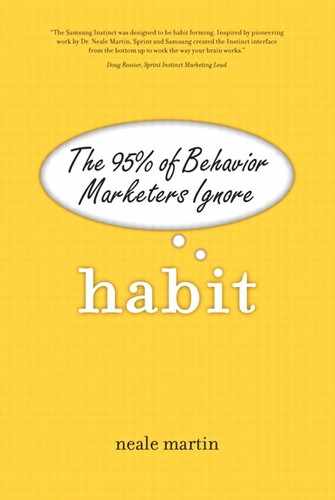Building Habits
Until this point, the focus has been on setting the stage in the customer’s mind for the behaviors that precede purchase and use. The focus now turns to habit-forming product management—managing products and services so that customers use them habitually. In brief, most of our customers’ shopping behavior is not consciously thought out, but is the result of established habits. But not all habits are the same. It is useful to think of two forms of habits: automatic habits and rule-based habits.
Automatic habits, such as Nielsen’s shopping on autopilot, occur when a problem has been solved enough times that the executive mind can turn it over to the habitual mind. This occurs in stable conditions, such as when a customer shops at the same store or uses a familiar web site to book airline tickets. Think of habits as shortcuts customers take to keep their executive mind free to solve novel problems. An automatic repurchase habit might mean that a customer is loyal to your brand or, conversely, that the customer doesn’t even give your brand a thought.
Rule-based habits, or heuristics, are those that rely on mental formulas to solve problems on the fly. A customer might have a rule that says “Don’t buy extended warranties” or “When this brand is on sale, stock up.” Most of the time, these rules are as unconscious as other habitual behaviors.
One of my marketing professors once described how he makes purchase decisions by drawing an S-shaped price-performance curve on a grease board. He pointed to the place where the line crested before heading off to the right, representing the point of highest value. “I shop here,” he said proudly. Most of us aren’t Indian-trained engineers with marketing Ph.D.s, so our heuristics are normally more obscure. But the point is important: We all develop strategies to speed us through purchase and usage decisions. After they are created, our heuristics give us one less complex thing to think about.
In real life, we use a combination of strategies to solve the countless decisions that confront us every day. Our executive and habitual minds are constantly trading off responsibilities, evaluating whether an automated response, a rule, or conscious problem solving is the best way to handle any given situation.
Almost every task combines these mental functions. Let’s look at a common high-involvement purchase—buying a flat-panel television. Your starting point would likely be to go online to gather information. Automatically, you Google “flat-panel television” and the search returns millions of hits. Your conscious mind is engaged as you scan the first couple of pages but is quickly overwhelmed by the amount of information Google returns.
You then might employ a rule-based strategy, such as using the familiar web site like CNet or Consumer Reports. Searching on these sites returns more useful information, and your executive mind is once again engaged. Unfortunately, the technical distinctions between plasma and LCD make it difficult to understand which is better. You make it to the actual recommendations section, but so many caveats exist that no particular product, much less brand, stands out.
This experience often results in a decision not to purchase, but you are committed and decide to take your little bit of knowledge and numerous questions to a store and talk to a salesperson. This leads to another decision—which store to visit. Because you are undecided and are looking for information, you bypass the big box store and go to an electronics retailer that specializes in customer service.
Entering the store, you begin looking at the flat panels on display. You try to remember which display was supposed to have a sharper image, which had better contrast, and which was supposed to handle motion better, and whether you can tell the difference. When a salesperson approaches, you feel relieved to be able to discuss your quandary.
Although your conscious mind is attentive, you are unconsciously processing body language, facial expressions, and other cues to determine trustworthiness. Is he trying to sell you something or is he listening to what you want? You like the guy but still aren’t sure if you trust him. However, after listening to you describe the room where the TV will reside, he not only suggests that you go with plasma, but he also recommends your favorite electronics brand. This triggers a rule-based decision, buying a trusted brand amid high levels of uncertainty.
Although most purchase or usage situations are not this involved, virtually all have the potential to activate both executive and habitual mental processes. Managing a product for habit formation requires a reformulation of our understanding of marketing and customer behavior.
